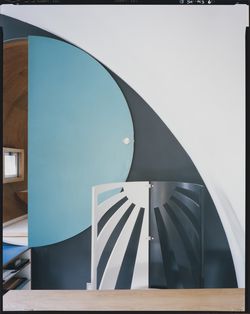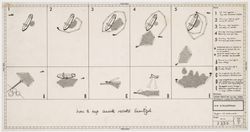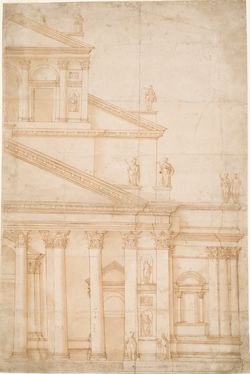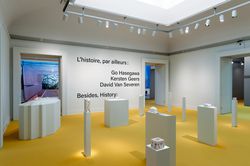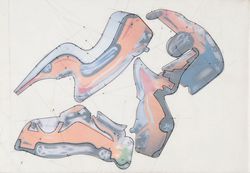Main galleries Keyword(s):
Jean-Louis Cohen, Amerikanizm, Russian architecture, Soviet Union, United States, USSR
13 November 2019 to 26 July 2020
Main galleries Keyword(s):
Jean-Louis Cohen, Amerikanizm, Russian architecture, Soviet Union, United States, USSR
Kazuo Shinohara was a deeply influential figure in postwar architecture in Japan best known for his individual houses, but he remains little studied today, especially outside Japan. Shinohara connected traditional forms and an investigation of modernist tenets with the high-tech and information technology moments yet to come. What was his attitude toward history, and how(...)
Paul Desmarais Theatre Keyword(s):
David B. Stewart, Kazuo Shinohara, What is/was history for…
21 September 2017, 6:30pm
David B. Stewart, what was history for Kazuo Shinohara?
Actions:
Description:
Kazuo Shinohara was a deeply influential figure in postwar architecture in Japan best known for his individual houses, but he remains little studied today, especially outside Japan. Shinohara connected traditional forms and an investigation of modernist tenets with the high-tech and information technology moments yet to come. What was his attitude toward history, and how(...)
Paul Desmarais Theatre Keyword(s):
David B. Stewart, Kazuo Shinohara, What is/was history for…
Environmental Histories
To kick off “Architecture and/for the Environment” —the CCA’s third Multidisciplinary Research Project funded by the Andrew W. Mellon Foundation—Daniel Abramson and Imre Szeman will present two key concepts that reconceive the environment in the history of architecture. Daniel Abramson, an architectural historian, will discuss how the idea of architectural “obsolescence”(...)
Paul Desmarais Theatre
15 December 2016, 6pm
Environmental Histories
Actions:
Description:
To kick off “Architecture and/for the Environment” —the CCA’s third Multidisciplinary Research Project funded by the Andrew W. Mellon Foundation—Daniel Abramson and Imre Szeman will present two key concepts that reconceive the environment in the history of architecture. Daniel Abramson, an architectural historian, will discuss how the idea of architectural “obsolescence”(...)
Paul Desmarais Theatre
Project
AP207.S1.2014.PR01
Description:
The project series documents the installation "Architettura "Correta"" designed by Pettena for the exhibition "Soleil Politique" at the Museion in Bolzano, in 2014. The project was a design for a new museum entrance. The installation was made of three glass walls on which were drawn facade details of three historical buildings of the city. The central glass wall represents the entrance from the Piacentini square in Bolzano, with, at its left, a ‘serlian’ arch, and, at its right, a detail of the portico of a ‘Piazza d’Italia’ by Giorgio de Chirico. The idea was to "connect the museum to the city’s history, an architectural element was chosen, one which, in addition to favoring the idea of ‘entrance’ to the exhibit also permitted a view both of the urban and the natural setting, the sky, the mountains, an environment typical of the area in which the city itself rises." [1] The project series contains a sketch and a spiral bound volume with correspondence between Pettena and Pierre Bal Blanc, curator of the exhibitions, and proposals for the installation. The project series also contains photographs of the installation, including printouts. Source: [1] Gianni Pettena website, https://www.giannipettena.it/italiano/opere-1/inst-revised-architecture-2014/ (last accessed 27 January 2020)
2014-2015
Architettura "Correta" ["Revised" Architecture] (2014)
Actions:
AP207.S1.2014.PR01
Description:
The project series documents the installation "Architettura "Correta"" designed by Pettena for the exhibition "Soleil Politique" at the Museion in Bolzano, in 2014. The project was a design for a new museum entrance. The installation was made of three glass walls on which were drawn facade details of three historical buildings of the city. The central glass wall represents the entrance from the Piacentini square in Bolzano, with, at its left, a ‘serlian’ arch, and, at its right, a detail of the portico of a ‘Piazza d’Italia’ by Giorgio de Chirico. The idea was to "connect the museum to the city’s history, an architectural element was chosen, one which, in addition to favoring the idea of ‘entrance’ to the exhibit also permitted a view both of the urban and the natural setting, the sky, the mountains, an environment typical of the area in which the city itself rises." [1] The project series contains a sketch and a spiral bound volume with correspondence between Pettena and Pierre Bal Blanc, curator of the exhibitions, and proposals for the installation. The project series also contains photographs of the installation, including printouts. Source: [1] Gianni Pettena website, https://www.giannipettena.it/italiano/opere-1/inst-revised-architecture-2014/ (last accessed 27 January 2020)
Project
2014-2015
The history of architecture addresses the relationships between spaces, buildings, urban geometries, and social practices—it tells us how an experience of space corresponds to an experience of the world. To this end, this lecture will analyze the sixteenth-century debate around the completion of the facade of the Basilica of San Petronio in Bologna, partially built in the(...)
Paul Desmarais Theatre Keyword(s):
Guido Beltramini, church of San Petronio, Bologna, Andrea Palladio, Baldassare Peruzzi, Giacomo da Vignola
5 October 2017, 6:30pm
Guido Beltramini, what was history for patrons and architects in Bologna in 1579?
Actions:
Description:
The history of architecture addresses the relationships between spaces, buildings, urban geometries, and social practices—it tells us how an experience of space corresponds to an experience of the world. To this end, this lecture will analyze the sixteenth-century debate around the completion of the facade of the Basilica of San Petronio in Bologna, partially built in the(...)
Paul Desmarais Theatre Keyword(s):
Guido Beltramini, church of San Petronio, Bologna, Andrea Palladio, Baldassare Peruzzi, Giacomo da Vignola
What role can history play in contemporary architecture practice? Rather than adopting a postmodern attitude or evoking past discussions and historical architectural forms, Go Hasegawa, Kersten Geers, and David Van Severen address contemporary issues in their work while remaining in dialogue with history. Even with distinct pasts and contexts, affinities emerge in shared(...)
Main galleries Keyword(s):
Besides, History, Go Hasegawa, Kersten Geers, David Van Severen, Office, KGDVS, Bas Princen
10 May 2017 to 15 October 2017
Besides, History: Go Hasegawa, Kersten Geers, David Van Severen
Actions:
Description:
What role can history play in contemporary architecture practice? Rather than adopting a postmodern attitude or evoking past discussions and historical architectural forms, Go Hasegawa, Kersten Geers, and David Van Severen address contemporary issues in their work while remaining in dialogue with history. Even with distinct pasts and contexts, affinities emerge in shared(...)
Main galleries Keyword(s):
Besides, History, Go Hasegawa, Kersten Geers, David Van Severen, Office, KGDVS, Bas Princen
drawings, textual records
Quantity:
57 textual record(s) and reprographic copy(ies)
DR1997:0070:001-057
Description:
- Danforth's thesis included a written component. Danforth researched the history, function and program of the museum, modern art gallery or exhibition hall, taking suggestions from Mies van der Rohe and Walter Peterhans about which ones he should examine. The group of documents includes an incomplete draft of Danforth's written text, as well as research notes and illustrations of museums/exhibition spaces by architects including Schinkel (Altes Museum, Berlin), Le Corbusier (Pavillon des Temps Nouveaux, Paris and Palais de Tokyo, Paris), Henry van de Velde, and H.P. Berlage.
architecture, installation
1940-1943
Research notes, draft text, and illustrations for a graduate thesis for a small museum, Department of Architecture, Illinois Institute of Technology
Actions:
DR1997:0070:001-057
Description:
- Danforth's thesis included a written component. Danforth researched the history, function and program of the museum, modern art gallery or exhibition hall, taking suggestions from Mies van der Rohe and Walter Peterhans about which ones he should examine. The group of documents includes an incomplete draft of Danforth's written text, as well as research notes and illustrations of museums/exhibition spaces by architects including Schinkel (Altes Museum, Berlin), Le Corbusier (Pavillon des Temps Nouveaux, Paris and Palais de Tokyo, Paris), Henry van de Velde, and H.P. Berlage.
drawings, textual records
Quantity:
57 textual record(s) and reprographic copy(ies)
1940-1943
architecture, installation
textual records, photographs
AP197.S2.055
Description:
The box contains the portfolios/project descriptions of works of various architects and architectural firms. Portfolio include: the University of Iowa's School of Art and Art History by Steven Holl; the Integral House by Shim-Sutcliffe Architects; and the Sydney Opera House by Jorn Utzon
circa 2000-2010
Porfolios/project descriptions of the works of various architects and architectural firms
Actions:
AP197.S2.055
Description:
The box contains the portfolios/project descriptions of works of various architects and architectural firms. Portfolio include: the University of Iowa's School of Art and Art History by Steven Holl; the Integral House by Shim-Sutcliffe Architects; and the Sydney Opera House by Jorn Utzon
textual records, photographs
circa 2000-2010
In this lecture, Amy Kulper locates architecture’s “digital turn” in 1988, when Thomas Knoll invented Photoshop. Originally developed as an image-editing software, Photoshop fit neatly within the long history of optical correction in the discipline. Yet its ubiquity today also prompts new questions. Does Photoshop simply introduce logics of adjustment, correction, and(...)
Paul Desmarais Theatre
9 June 2016, 6pm
Amy Kulper: Architecture’s Digital Turn and the Advent of Photoshop
Actions:
Description:
In this lecture, Amy Kulper locates architecture’s “digital turn” in 1988, when Thomas Knoll invented Photoshop. Originally developed as an image-editing software, Photoshop fit neatly within the long history of optical correction in the discipline. Yet its ubiquity today also prompts new questions. Does Photoshop simply introduce logics of adjustment, correction, and(...)
Paul Desmarais Theatre
textual records
AP197.S2.006
Description:
The box is comprised of writings that relate to the development of architectural education, the role of history in architectural education, and various architectural organizations such as the Architectural Association and the Royal College of Art. The second half of the box is comprised of articles on architecture and art. .
circa 1970-1995
Reseach files on architectural education, architectural organizations and art
Actions:
AP197.S2.006
Description:
The box is comprised of writings that relate to the development of architectural education, the role of history in architectural education, and various architectural organizations such as the Architectural Association and the Royal College of Art. The second half of the box is comprised of articles on architecture and art. .
textual records
circa 1970-1995

